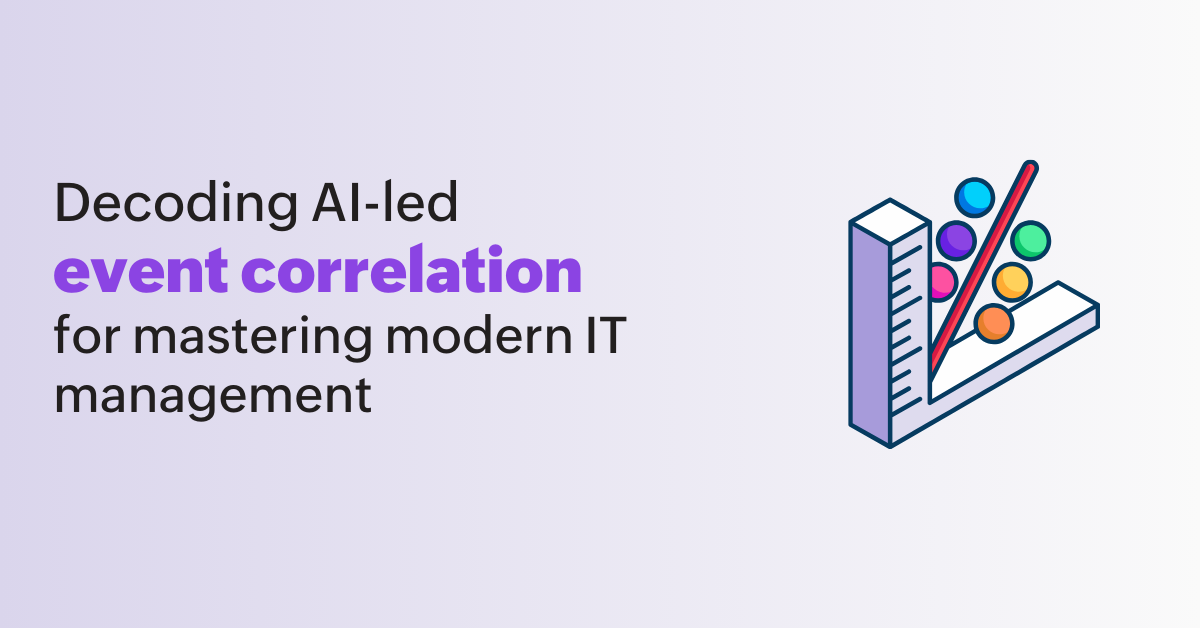Decoding AI-led event correlation for mastering modern IT management

"The whole is more than the sum of its parts," said Aristotle. This quote fits modern IT, where intricate, interwoven ecosystems of applications, microservices, networks, and databases interact dynamically. To ensure seamless operations, IT teams must decode these interactions: events and incidents. This blog explains events and incidents in IT observability and how AI-led event correlation with Site24x7’s Problems feature masters modern IT complexity.
Events are not always incidents
Not all events are incidents. In IT observability, an event is any detectable occurrence or change, such as a server request, API call, error log, or security breach. Events are vital for observability, the ability to understand system behavior externally. Critical events disrupting operations escalate into incidents, requiring immediate attention. AI-driven event correlation identifies emerging issues early, distinguishing routine operations from disruptive anomalies, unlike traditional tools lacking contextual intelligence.
Some observability challenges
Modern IT teams face several observability challenges:
- Hybrid and multi-cloud deployments : Managing workloads across on-premises, private, and public clouds creates fragmentation and blind spots.
- Rising cloud costs : Downtime and inefficient troubleshooting strain IT budgets.
- Data deluge and diversity : Terabytes of daily metrics, events, logs, and traces demand sifting through noise for actionable insights.
- Less time to resolve : Rising user expectations shrink resolution windows, limiting manual analysis.
- Tool sprawl : Disjointed tools create silos, hindering unified system health visibility.
AI-driven observability offers a smarter approach to tackle these challenges.
Challenges in tracking and responding to IT events
Modern IT event tracking goes beyond data collection, focusing on understanding relationships and patterns. How does a database query timeout connect to a network bottleneck? What are the chances a minor performance dip escalates into a major outage? Traditional monitoring relies on rigid, static rules prone to oversight, missing evolving norms and misleading teams into analyzing benign signals. This delays responses, making downtime costlier. A solution that intelligently interprets events is needed for proactive, decisive action.
Understanding event correlation
Event correlation analyzes relationships between disparate events to diagnose system health holistically, like piecing together a puzzle. Linked events reveal the bigger picture. Site24x7’s AI-led event correlation, via the Problems feature, analyzes historical and real-time data to uncover patterns and anomalies and predict incidents across the IT stack. For example, it correlates a CPU surge with a recent code push, enabling teams to roll back problematic code faster.
AIOps in event correlation
AIOps uses machine learning to train on historical data, spanning days to months, creating a baseline of normal behavior. New data is compared to detect deviations. Site24x7’s Problems feature groups related events (e.g., response time spikes or CPU breaches) into a single problem within a configurable time window (default: 10 minutes). Smart Groups organize interdependent monitors based on network topology, correlating events across infrastructure layers. Contextual analysis, including timestamps and dependencies, prioritizes issues for corrective action, avoiding firefighting.
Advantages of AI-led event correlation
AI-driven event correlation offers five key benefits over traditional monitoring:
- Efficiency leap : Automates tasks like log parsing and anomaly detection, freeing human resources.
- Noise reduction : Filters irrelevant alerts, focusing on high-priority issues.
- Eliminates alert fatigue : Intelligent alerting prevents false positives, reducing team overwhelm.
- Faster resolution : Pinpoints root causes quickly with the Trace Analysis feature for application monitors, cutting mean time to resolution.
- Proactive insights : Predicts issues before escalation, ensuring uninterrupted operations.
How Site24x7’s AIOps event correlation helps
Consider a global e-commerce platform facing intermittent slowdowns during peak hours. Traditional tools struggle to identify whether the issue stems from servers, APIs, or third-party integrations. Site24x7’s Problems feature analyzes weeks of data, correlating a response time spike with related events, such as a memory leak or microservice issue. Smart Groups organize affected monitors, and Trace Analysis drills down to code-level issues for supported monitors. This enables corrective actions like code fixes or rollbacks, ensuring smooth performance. AIOps transforms reactive monitoring into proactive observability.
Good IT management requires intelligent systems that predict and prevent issues, not just react. Adopting AI-driven observability is essential for a competitive edge. Move beyond outdated tools. Try Site24x7 today to transform IT operations with AI-led event correlation and achieve efficiency and higher customer satisfaction.